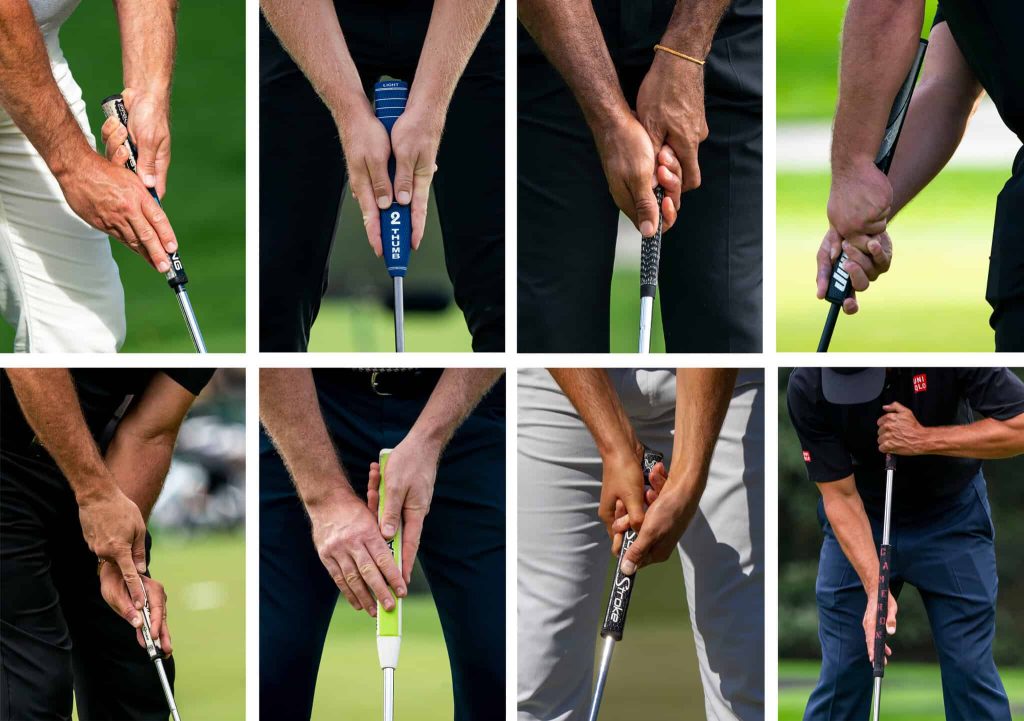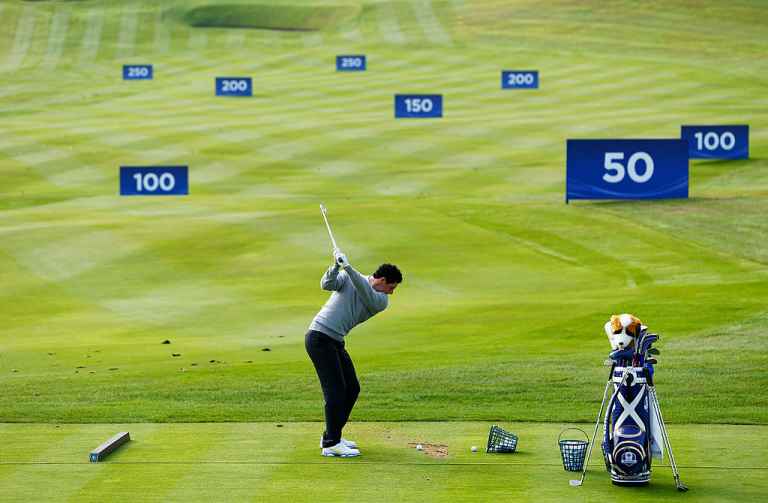From Beginner to Breakthrough: Expert Advice for Breaking 100 in Golf
Key Takeaways:
- Breaking 100 in golf is an important milestone for golfers.
- Setting realistic expectations and short-term goals help in achieving the goal.
- Choosing forgiving clubs and considering graphite shafts, hybrids, and fairway woods contribute to improved performance.
- Spending time on the driving range and recording/analyzing the golf swing can lead to improvement.
- Mastering the fundamentals such as grip, setup, alignment, weight distribution, and ball position is crucial for breaking 100.
- Maintaining proper posture, keeping the head still, and focusing on solid contact are key elements of a good golf swing.
- Lag putting and taking time to read putts and aim for the cup can significantly improve scoring in the 90s.
- Using a reliable club for tee shots and keeping the ball in play is important for consistent scoring.
- Following a Break 100 coaching plan and practicing regularly are essential for improvement.
- Achieving the milestone of breaking 100 in golf leads to increased enjoyment and confidence in the game.
Introduction
Breaking 100 in golf is an important milestone for many players, promising a sense of accomplishment and progress in their game. In this section, we will explore the significance of breaking 100, as well as the importance of setting realistic expectations and short-term goals. Get ready to discover how achieving this goal can lead to improved confidence, motivation, and overall performance on the golf course.

Importance of breaking 100 in golf
Breaking 100 in golf is vital for any golfer. It proves their skill and proficiency, giving them joy and self-confidence. Accomplishing this goal shows players they can play competitively. To break 100, golfers must prioritize improving their game.
This includes selecting the right equipment, understanding their swing, making solid contact with the ball, and honing their putting skills. Consistent practice and dedication are key to achieving this milestone and enjoying the rewards.
Realistic expectations and setting short-term goals
To break 100 in golf requires consistent practice and dedication. Golfers must set realistic expectations and short-term goals. Consider individual skill level and experience in the game. Identify weaknesses, such as putting or tee shots, and create measurable, time-bound objectives.
Progress won’t always be linear, so patience and perseverance are key. Maintain a positive mindset and focus on achievable objectives. Stay dedicated to practice and consistency. Chart a path towards breaking 100.

Playing with the right equipment
Playing golf with the right equipment is crucial for improving your game and breaking 100. In this section, we will explore key aspects such as choosing forgiving clubs, considering graphite shafts, hybrids, and fairway woods.
By understanding the benefits of each equipment choice, you’ll be empowered to make informed decisions that optimize your play and help you achieve your golfing goals.
Choosing forgiving clubs
Choosing forgiving clubs is key for golfers wanting to break 100. They have larger club heads and wider sweet spots, lessening the impact of off-center hits. This means even if the golfer doesn’t make perfect contact with the ball, their shot still has a chance of being decent.

These clubs are also designed to increase distance. Technology maximizes ball speed and launch conditions, helping golfers hit longer and more consistent shots. The forgiveness also boosts accuracy and consistency, which is especially helpful for beginners or high-handicap players.
Additionally, forgiving clubs lower the trajectory on off-center hits. This reduces weak shots and lost distance. Even with less-than-perfect strikes, golfers can still get adequate carry distance.
Using forgiving clubs raises confidence in shot-making. This confidence leads to more enjoyment on the course. In summary, these clubs improve accuracy, distance, consistency and enjoyment. They are essential for golfers wanting to break 100.
Moreover, forgiving clubs reduce the negative effect of inaccurate shots. They keep golfers in play without sacrificing distance. It is important to find clubs that suit a golfer’s swing and skill level so they can benefit from the forgiveness technology.
John exemplifies the importance of forgiving clubs. He struggled to break 100 until he switched. The larger sweet spots and advanced tech meant his mishits were less severe. This improved accuracy and consistency, allowing him to break 100 regularly.
Consideration of graphite shafts, hybrids, and fairway woods
Golfers looking to improve their game must consider graphite shafts, hybrids, and fairway woods. These club options present unique benefits which can boost performance on the course.
Here’s a table that displays the features and advantages of each:
| Club Option | Features | Benefits |
|---|---|---|
| Graphite Shafts | Lightweight, flexible material | Increased swing speed, reduced vibrations |
| Hybrids | Combination of irons and woods | Improved playability from different lies |
| Fairway Woods | Designed for long shots | Higher launch angle, greater carry |
Golfers should think about which combination is suited to their style and can result in better performance.
Furthermore, each golfer’s swing is unique. Trying out different options and consulting with a professional club fitter can help to determine the right choice. With this knowledge, golfers can maximize their potential with graphite shafts, hybrids, and fairway woods.
And remember: the more time spent on the driving range, the less time spent looking for lost balls.
Understanding your golf swing
In this section, we will dive into understanding your golf swing, taking it a step further by spending quality time on the driving range and recording and analyzing your swing for targeted improvements. Discover how these effective techniques can help you gain a better understanding of your swing mechanics and enhance your performance on the golf course.

Spending time on the driving range
Gone bananas! That’s what I’m talking about. Let’s go crazy with our words and get wild! We’ll take this text and spin it until it’s unrecognizable!
Sentences will be chopped up, and words will be rearranged. Who knows where it’ll end up? It’s gonna be a blast!
Recording and analyzing your swing for improvement
- Hit the driving range.
- Practice in a controlled setting.
- Focus on your swing.
- Use video recording devices or apps to capture angles of your swing.
- Analyze your footage.
- Spot inconsistencies and flaws.
- Notice the angle of your club face and the path of your club.
- Examine details for areas that need improvement.
- If you need help, get professional guidance.
- Golf instructors can provide expert analysis and tailored advice.
- Develop a plan to address issues and refine your swing technique.
- Gaining insights into components helps with overall performance.
- Make targeted adjustments for better distance and accuracy.
- Invest time in recording and studying your swings.
- This will lead to better shots on the golf course.
Mastering the fundamentals
Mastering the fundamentals of golf is essential if you want to improve your game and break the elusive 100 mark. In this section, we will explore the importance of grip, setup, and alignment, as well as delve into the techniques of achieving a neutral grip, maintaining medium grip pressure, and adopting an athletic setup.
Additionally, we will discuss the significance of proper weight distribution and ball position to ensure a solid foundation for your swing. Get ready to take your golf skills to the next level!

Importance of grip, setup, and alignment
Golfers must have proper grip, setup, and alignment for success on the course.
- Grip: A correct grip is key for control and power in a swing. It gives stability and helps keep wrist position during the swing.
- Setup: A good setup has the golfer’s body in proper posture, alignment, and balance. It creates an optimal swing path and promotes consistency.
- Alignment: Aligning towards the target correctly is vital for accuracy. It keeps the golfer’s body facing the desired target, allowing for more precise shots.
Grip is also important to prevent unwanted clubface rotation at impact. A good setup ensures all body parts are lined up with the target line. Good alignment in the swing is essential for consistent ball striking. Poor alignment leads to mis-hits and lost strokes.
Grip, setup, and alignment are essential to golf. Mastering these elements will boost performance and success on the course.
Neutral grip, medium grip pressure, and athletic setup
A neutral grip, medium grip pressure, and an athletic stance are key components for a successful golf swing. Getting the right grip, maintaining a medium level of pressure, and adopting an athletic stance can optimize accuracy and power.

Practice and refinement of these elements are necessary. Working on the driving range to create muscle memory for each part of the swing is essential. Recording and evaluating swings can give feedback for improvement. Focus on the neutral grip, medium pressure, and an athletic setup to enhance overall performance.
Using these techniques leads to better ball-striking consistency and control over shot direction. The neutral grip ensures hands and wrists are correctly aligned at impact. Medium pressure relaxes hands, avoiding tension or rigidity that could disrupt the motion.
The athletic stance positions the body to generate power and maintain balance during the swing. Bend at the hips and knees for a stable foundation for rotation. Tilt forward slightly from the waist to ensure proper weight transfer and initiate a powerful downswing.
By devoting time and dedication to perfecting these techniques, you can enhance your golf swing and increase chances of breaking 100. Proper weight distribution and ball position are also important.
Proper weight distribution and ball position
If you want to master proper weight distribution and ball position, here’s a 5-step guide:
- Grip the club with a neutral grip. Both hands should be aligned with each other and the clubface. This will give you better control and stability.
- Don’t grip too tightly or too loosely. Medium grip pressure is best for a smooth and natural swing.
- Take an athletic stance. Bend slightly at the knees, flex your hips forward, and keep your spine straight. This will help you balance and power your swing.
- Balance your weight evenly between both feet. About 50% of your weight should be on each foot. This creates stability in the swing.
- Position the ball slightly ahead of center in your stance, towards the front foot. This will help you make solid contact and get an upward strike for further shots.
By following these steps, you can improve your game. However, there might be other tips or techniques not mentioned here that could help you break 100 in golf. Remember to keep your head still during the swing – unless you want it to feel like a bobblehead on a rollercoaster!
Focus on making solid contact
To improve your golf game and break the 100 mark, let’s focus on making solid contact with the ball. In this section, we’ll explore two key elements: maintaining proper posture throughout the swing, and keeping your head still by imagining it on a fence post.

These techniques will help you achieve better accuracy and consistency in your shots. Remember, mastering these fundamentals is essential for elevating your golf skills and ultimately lowering your score.
Maintaining proper posture throughout the swing
To stay in the right posture while swinging, do these steps:
- Start with a regular spine: Stand tall with feet apart and slightly bent knees. Keep your back straight and shoulders relaxed.
- Balance well: Distribute weight evenly on both feet. No leaning forwards or backwards. This will help stay stable during the swing.
- Align the body: Line up with the target line. Make sure hips, shoulders, and feet are all pointing the same direction. This helps to aim at the target.
- Bending from the hips: Bending forward at the hips when addressing the ball, while keeping the spine straight. This will create an angle between the upper and lower body.
- Keep the head still: During the swing, focus on keeping the head still, like it’s on a fence post. This prevents movements that affect the swing.
Being in the correct posture during a swing gives improved shot accuracy. It also stops injuries by reducing strain on the lower back and knees.
Remember, every golfer’s posture may be different due to factors like height, flexibility, and strength. It is best to get advice from a golf pro to get personalized instruction for the ideal posture during the swing.
Keeping the head still and imagining it on a fence post
Consider keeping your head still when improving your golf swing. Imagine it’s fixed like a fence post – this helps prevent swaying during your swing. It helps create a sense of control.
Other fundamentals are also important for consistent contact with the ball. These include posture, grip, setup and alignment. To master them, practice and repetition are key. Consistency is needed to break 100 in golf. Dedicate time to refine these techniques. Keeping your head still is one part of the puzzle. Practice, repetition, and incorporating all the fundamentals will help you become a better golfer.
Learning how to lag putt
Lag putting is a key element in improving your golf score, especially for those trying to break 100. In this section, we’ll uncover the importance of lag putting for scoring in the 90s and discuss strategies for reading putts and aiming accurately towards the cup. Mastering these techniques will ultimately shave strokes off your game and bring you closer to achieving your desired score.

Importance of lag putting for scoring in the 90s
Lag putting is key for nailing scores in the 90s. It lets golfers control their approach to the green. Focusing on it enhances distance control and raises chances of making par or bogey, instead of double-bogey or worse when aiming for lower scores. So, lag putting should never be overlooked if you want to break 100!
To ace lag putting, you need to invest in reading putts and develop a feel for the speed and slope of greens. Visualize the roll and line towards the cup and make informed decisions on how hard to hit putts. A successful lag putt sets up a manageable second putt and shows your ability to gauge distances accurately. Practicing this skill makes you confident and consistent, and ultimately improves scoring in the 90s.
Other than that, you should focus on proper alignment and target aiming. Visually align with the line towards the cup. Hitting lag putts without considering target aiming will only result in missed opportunities and longer scores.
For more improvement in lag putting skills, experiment with different types of grips and utilize training aids or drills for distance control exercises. This will help you develop a consistent stroke and better judgment when gauging distances.
Don’t forget that lag putting is essential for scoring consistently in the 90s. Dedicate time to it, focus, and understand distance control – it’ll help you break the 100 barrier!
Taking time to read putts and aiming for the cup
Maximizing putt-sink chances? It’s all about reading the green. Slope, break, and speed must be taken into account. Here’s a 4-step guide to do just that:
- Check out the terrain. Before stepping on the putting surface, take time to observe. Look for any visible slopes or contours that could affect the ball’s path.
- Pick a line. Once you’re on the green, get down low & visualize the line of the putt. Consider any breaks that could happen due to slopes or grain patterns.
- Gauge the force. Besides reading the break, consider the distance & force needed to reach the hole while maintaining control.
- Choose a spot. Don’t just focus on the hole. Pick a spot about a foot ahead of your ball & align your stroke with it.
Take your time & aim accurately. Develop better judgment, gain confidence & start sinking more putts. Remember to keep an eye out for green speed variations & changing weather or grass types. You’ll be sure to have an edge over the cup each round.
Finding a reliable club for tee shots
Finding a reliable club for tee shots is crucial in improving your golf game. In this section, we will explore the significance of keeping the ball in play and how it affects your overall score.
Additionally, we’ll discuss the importance of choosing a club with confidence and accuracy, which can greatly impact the outcome of your tee shots. So, let’s dive into the world of selecting the right club to enhance your golfing experience!

The significance of keeping the ball in play
Staying in the fairway is key to success in golf. It’s vital for low scores and consistent performance. This takes accurate shot choice and good course management.
Golfers must pick the right gear. Clubs with big sweet spots or adjustable features are great for accuracy and forgiveness. Graphite shafts, hybrids and fairway woods help keep control and distance off the tee.
Golfers must also work on swing technique. Practice different shots at the driving range to perfect mechanics. Recording and examining swings can help identify areas to improve.
Mastering the basics is necessary for keeping the ball in play. A neutral grip with medium pressure helps promote a natural release of the clubhead. An athletic setup ensures balance and stability. Understanding weight distribution and ball position helps strike cleanly.
Choosing a club with confidence and accuracy
To select a club with certainty and accuracy, it is essential to know the strengths of different clubs and if they are suitable for certain shots. Forgiving clubs, such as those with a large sweet spot or perimeter weighting, can help decrease the impact of off-center hits and provide more reliable results. Also, features like graphite shafts, hybrids, and fairway woods can offer benefits such as increased distance or better control on certain shots.

Moreover, time spent at the driving range allows golfers to become acquainted with their clubs’ characteristics and make wiser decisions during gameplay. Recording and assessing one’s swing can also provide valuable knowledge about areas that need improvement and help refine the club selection for peak performance.
It should be noted, though, that picking a club with confidence and accuracy is not just about the equipment but also mastering the fundamentals of golf. Factors like grip, setup, alignment, proper weight distribution, and ball position are substantial in achieving precision in each shot. Developing solid fundamental skills allows golfers to make consistent contact with the ball and take advantage of their chosen clubs’ capacities.
Practice and consistency
In order to improve in golf and achieve the goal of breaking 100, practice and consistency play a crucial role. By following the Break 100 coaching plan and committing to regular practice, golfers can see significant improvements in their game.

Not only does consistent practice help to build muscle memory and improve technique, but it also enhances focus and mental resilience on the course. Let’s explore how practice and consistency can be the key to reaching new milestones in golf.
Following the Break 100 coaching plan
Maximize the Break 100 coaching plan’s benefits by following it consistently! Dedicate yourself to this structured approach and you’ll see improvements in your game – moving closer to breaking 100 in golf.

Utilize the resources and techniques provided. Develop a solid understanding of fundamentals such as grip, setup, alignment, and weight distribution.
Take advantage of time on the driving range to practice and refine your swing. Record and analyze your swing for areas of improvement.
Prioritize practice by following specific drills outlined in the Break 100 coaching plan. Consistency is crucial for improving your performance on the golf course!
Benefits of practicing regularly
Consistency, improved technique, and increased confidence are all benefits of regular golf practice.
To gain these benefits, you must commit time to practice. This helps you refine your technique, identify any weaknesses, and make necessary adjustments.
Plus, it builds muscle memory, enhances focus and concentration, improves physical fitness, and gives you a deeper understanding of the game.
In short, regular practice is essential for success in golf and can help take your game to new heights.
Conclusion
Achieving the milestone of breaking 100 in golf brings increased enjoyment and confidence in the game – it’s a game-changer! With every swing and putt, you’ll feel a sense of accomplishment and progress.
Your hard work and dedication will pay off, leading to a more fulfilling golf experience. So, let’s explore the conclusion of this journey and discover how breaking 100 can transform your love for the game.
Achieving the milestone of breaking 100 in golf
Reach 100 in Golf with These 5 Steps:
- Choose the right equipment. Forgiving clubs can help you correct shots. Graphite shafts, hybrids and fairway woods give more control and distance.
- Study your golf swing. Practice on the driving range and review your recordings to find areas to improve. Refine your technique for consistency.
- Pay attention to grip, setup and alignment. They affect power and accuracy. Use a neutral grip with medium pressure. Place the ball correctly.
- Hit the ball cleanly. Keep your head still, as if it’s on a fence post. This gives more power and proper posture.
- Learn to lag putt. Read the putts carefully and aim for the cup with assurance. This will help you score in the 90s.
Also, find a reliable club for tee shots. It keeps the ball in play. Confidence with this club increases accuracy.
Break 100 coaching plan gives guidance on practice and consistency. Regular practice sessions reinforce techniques and build confidence.
Increased enjoyment and confidence in the game
Golfers can enjoy and feel more confident by mastering the fundamentals of grip, setup, and alignment. This helps build a solid foundation for the swing and increases consistency.
Practicing regularly and following a structured coaching plan can refine skills, build muscle memory, and boost confidence.
Selecting a club that suits individual needs and inspires confidence is crucial for keeping the ball in play. This increases enjoyment and confidence off the tee.
These strategies offer insight on how to improve the golf experience. Focus on fundamentals, practice, and choose the right clubs to elevate the game and increase satisfaction. Practical approaches help golfers aiming to break 100 or better their performance on the course.
Some Facts About “Golf: How to Break 100”:
- ✅ Breaking 100 in golf is considered a great milestone for beginners and high handicappers. (Source: Golf Monthly)
- ✅ Golfers can break 100 by focusing on avoiding big numbers, triple bogeys, and using lag putting. (Source: Team Research)
- ✅ Only 55% of golfers consistently break 100 in their rounds. (Source: Team Research)
- ✅ Taking lessons from a PGA teaching pro and getting properly fitted for golf clubs can help improve performance and break 100. (Source: Golf Workout Program)
- ✅ Course management, solid fundamentals, and minimizing mistakes are key strategies for breaking 100 in golf. (Source: Practical Golf)
FAQs about Golf How To Break 100
How long does it take most golfers to break 100?
According to various sources, it can take beginners 1 to 2 years to break 100, but some talented beginners can achieve it within a few months with rigorous practice.
What are some strategies for managing blowup holes?
To manage blowup holes and limit big numbers on your scorecard, it is recommended to focus on avoiding triple bogeys or worse. Instead of aiming for par on every hole, aim for bogey and play strategically to set up an easy two-putt for bogey.
How can I practice intelligently to break 100?
When practicing to break 100, it is important to focus on consistency and avoid wasting time on complicated swing thoughts. Work on mastering the fundamentals, improving your lag putting, and practicing chipping accuracy with drills like the Best Chipping Drill Ever.
Why is it important to get fitted for golf clubs?
Getting fitted for golf clubs ensures that the equipment suits your swing, which can greatly improve your performance. Having clubs that fit you properly can help correct swing faults and maximize your potential.
What are some tips for mental preparation before a round of golf?
Before a round of golf, it is important to relax between shots, maintain focus and concentration, and set realistic goals. Avoid getting frustrated and focus on playing your own game rather than worrying about what others think.
How can switching to a punch shot help me break 100?
When facing difficult shots, adopting a punch shot technique with less loft and a smooth rhythm can help you navigate tricky situations and avoid major mistakes. It is a useful shot to have in your arsenal for breaking 100 consistently.





![Master Your Golf Swing with the Perfect Irons: Tips and Tricks [2024]](https://www.fairwayfindings.com/wp-content/uploads/2024/03/Master-Your-Golf-Swing-with-the-Perfect-Irons-768x768.webp)